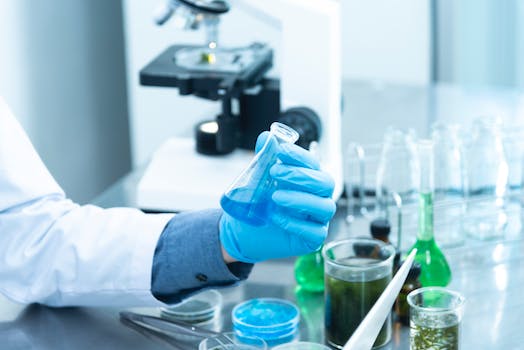

-
Table of Contents
Where Love Meets Logic
Introduction
Exploring the Intersection of Romance and Science
Romance and science are two seemingly distinct realms of human experience. Romance is often associated with emotions, passion, and the complexities of human relationships, while science is typically linked to logic, reason, and the pursuit of knowledge. However, upon closer examination, it becomes evident that these two domains are not mutually exclusive. In fact, there exists a fascinating intersection between romance and science, where the exploration of human emotions and relationships can be informed and enhanced by scientific understanding. This intersection offers a unique perspective on the complexities of love, attraction, and the dynamics of romantic relationships, shedding light on the intricate interplay between our hearts and our minds. In this exploration, we delve into the fascinating world where romance and science converge, uncovering insights that can deepen our understanding of the human experience.
The Role of Chemistry in Romantic Relationships
Exploring the Intersection of Romance and Science
Romantic relationships have long been a subject of fascination for scientists and researchers. While love and chemistry may seem like two completely different realms, there is actually a significant overlap between the two. In fact, the role of chemistry in romantic relationships is a topic that has garnered much attention in recent years.
Chemistry, in the context of romantic relationships, refers to the intense emotional and physical attraction that individuals feel towards each other. It is often described as a spark or a connection that is difficult to explain but is undeniably present. This chemistry is believed to be influenced by a variety of factors, including hormones, pheromones, and neurotransmitters.
One of the key players in the chemistry of romantic relationships is oxytocin, often referred to as the "love hormone." Oxytocin is released during physical touch, such as hugging or kissing, and is associated with feelings of trust, bonding, and attachment. Research has shown that higher levels of oxytocin are present in individuals who are in love or in long-term relationships. This suggests that oxytocin plays a crucial role in fostering emotional connections between partners.
Another important chemical component of romantic relationships is dopamine. Dopamine is a neurotransmitter that is associated with pleasure and reward. It is released in response to positive experiences, such as spending time with a loved one or engaging in activities that bring joy. The release of dopamine creates a sense of euphoria and reinforces the desire to seek out those pleasurable experiences. This is why spending time with a loved one can feel so rewarding and addictive.
In addition to oxytocin and dopamine, other hormones and neurotransmitters also play a role in the chemistry of romantic relationships. For example, serotonin, a neurotransmitter that regulates mood, has been linked to feelings of infatuation and obsession. When serotonin levels are low, individuals may experience intense longing and desire for their romantic partner. On the other hand, high levels of serotonin can lead to feelings of contentment and stability in a relationship.
While the chemical aspects of romantic relationships are fascinating, it is important to note that they are just one piece of the puzzle. Love and relationships are complex and multifaceted, influenced by a wide range of factors including personal experiences, cultural norms, and individual preferences. Chemistry alone cannot sustain a relationship, but it can certainly enhance the emotional connection between partners.
Understanding the role of chemistry in romantic relationships can have practical implications as well. For example, couples who are aware of the chemical processes at play may be better equipped to navigate the ups and downs of their relationship. They may also be more inclined to engage in activities that promote the release of oxytocin and dopamine, such as physical touch and shared experiences.
In conclusion, the role of chemistry in romantic relationships is a fascinating area of study. Oxytocin, dopamine, and other hormones and neurotransmitters all contribute to the intense emotional and physical attraction that individuals feel towards each other. While chemistry alone cannot sustain a relationship, it can certainly enhance the bond between partners. By understanding the chemical processes at play, couples may be able to strengthen their connection and navigate the complexities of love more effectively.
The Influence of Technology on Modern Love Stories

In today's digital age, technology has become an integral part of our lives, shaping the way we communicate, work, and even find love. The influence of technology on modern love stories is undeniable, as it has revolutionized the way we meet, connect, and maintain relationships. From online dating platforms to long-distance relationships facilitated by video calls, technology has opened up new possibilities and challenges in the realm of romance.
One of the most significant ways technology has impacted modern love stories is through the rise of online dating. Gone are the days of meeting potential partners through chance encounters or introductions by friends. With just a few clicks, individuals can now browse through countless profiles, filtering their preferences to find someone who matches their criteria. This convenience has made dating more accessible and efficient, allowing people to connect with others they may have never met otherwise.
However, the prevalence of online dating also brings its own set of challenges. The abundance of choices can lead to a paradox of choice, where individuals struggle to commit to one person due to the fear of missing out on someone better. Moreover, the reliance on online profiles and algorithms to match individuals can sometimes lead to a superficial approach to dating, where appearances and interests take precedence over deeper connections.
Technology has also played a significant role in maintaining long-distance relationships. In the past, distance often meant the end of a romantic relationship, as the lack of physical proximity made it challenging to stay connected. However, with the advent of video calls, messaging apps, and social media, couples can now bridge the gap and maintain a sense of closeness despite being miles apart.
While technology has undoubtedly made long-distance relationships more manageable, it also presents its own set of obstacles. The reliance on virtual communication can sometimes lead to a sense of detachment, as physical touch and non-verbal cues are absent. Additionally, the constant availability of technology can blur the boundaries between personal and professional life, making it challenging to disconnect and fully engage with one's partner.
Another aspect of technology's influence on modern love stories is the role of social media. Platforms like Facebook, Instagram, and Twitter have become virtual stages where individuals showcase their relationships to the world. Couples often share their romantic milestones, vacations, and even arguments, creating a curated narrative of their love story. While this can be a way to celebrate and document their relationship, it can also create pressure to present an idealized version of love, leading to feelings of inadequacy and comparison among couples.
Furthermore, social media can also become a breeding ground for jealousy and mistrust. The constant exposure to other people's seemingly perfect relationships can create insecurities and doubts within individuals, leading to conflicts and misunderstandings. The need for validation through likes and comments can also take precedence over genuine connection, as couples strive to portray an image of happiness rather than addressing underlying issues.
In conclusion, technology has undeniably shaped the landscape of modern love stories. From the convenience of online dating to the challenges of maintaining long-distance relationships, technology has opened up new possibilities while also presenting its own set of obstacles. It is essential for individuals to navigate these advancements mindfully, ensuring that technology enhances rather than hinders their connections. By striking a balance between virtual and physical interactions, couples can harness the power of technology to foster genuine and meaningful relationships in the digital age.
The Fascinating Science Behind Attraction and Love
The intersection of romance and science is a captivating field that delves into the intricate workings of attraction and love. While romance may seem like a purely emotional and subjective experience, scientists have been able to uncover some fascinating insights into the science behind these phenomena. By studying the brain, hormones, and evolutionary biology, researchers have shed light on the mechanisms that drive attraction and love.
One of the key areas of study in this field is the brain. Neuroscientists have discovered that when we are attracted to someone, certain areas of our brain become activated. The reward center, which is responsible for feelings of pleasure and motivation, lights up when we see someone we find attractive. This suggests that attraction is not purely based on physical appearance, but also on the brain's response to certain stimuli.
Furthermore, researchers have found that love and attraction are closely linked to the release of certain hormones. When we are attracted to someone, our bodies produce higher levels of dopamine, a neurotransmitter associated with pleasure and reward. This surge of dopamine creates a sense of euphoria and excitement, which is often described as the "butterflies in the stomach" feeling. Additionally, the hormone oxytocin, often referred to as the "love hormone," plays a crucial role in bonding and attachment. Oxytocin is released during physical touch, such as hugging or kissing, and promotes feelings of trust and intimacy.
Evolutionary biology also plays a significant role in understanding attraction and love. According to evolutionary psychologists, our preferences in a romantic partner are shaped by our evolutionary history. For example, men tend to be attracted to physical features that indicate fertility and health, such as a symmetrical face or an hourglass figure. This preference is believed to be rooted in the desire to find a mate who can bear healthy offspring. On the other hand, women are often attracted to traits that suggest strength and resources, as these qualities would have been advantageous for survival and providing for offspring in our ancestral past.
Interestingly, research has also shown that the initial stages of romantic love can be similar to the experience of addiction. When we are infatuated with someone, our brains release high levels of dopamine, similar to the reward response seen in drug addiction. This may explain why people often feel a strong craving and obsession for their romantic partner during the early stages of a relationship. Over time, however, the brain's response to love changes, and the intense feelings of infatuation give way to a deeper, more stable form of love.
Understanding the science behind attraction and love not only provides us with fascinating insights into human behavior but also has practical implications. For example, therapists and relationship counselors can use this knowledge to help couples navigate the complexities of their relationships. By understanding the biological and psychological factors that contribute to attraction and love, individuals can gain a deeper understanding of their own emotions and make more informed decisions about their relationships.
In conclusion, the intersection of romance and science offers a captivating glimpse into the mechanisms that drive attraction and love. Through the study of the brain, hormones, and evolutionary biology, researchers have uncovered fascinating insights into the science behind these phenomena. By understanding the intricate workings of attraction and love, we can gain a deeper understanding of ourselves and the complexities of human relationships.
Q&A
1. What is the intersection of romance and science?
The intersection of romance and science refers to the exploration and study of the scientific aspects of romantic relationships, including the psychological, physiological, and sociological factors that influence attraction, love, and relationship dynamics.
2. Why is exploring the intersection of romance and science important?
Exploring the intersection of romance and science is important because it allows for a deeper understanding of human relationships and can provide insights into how to foster healthy and fulfilling romantic connections. It also helps debunk myths and misconceptions about love and provides evidence-based strategies for improving relationship satisfaction.
3. What are some areas of research within the intersection of romance and science?
Some areas of research within the intersection of romance and science include studying the role of hormones and neurotransmitters in attraction and love, examining the impact of attachment styles on relationship dynamics, investigating the influence of cultural and societal factors on romantic relationships, and exploring the effectiveness of various interventions and therapies for relationship enhancement.
Conclusion
In conclusion, exploring the intersection of romance and science offers a fascinating perspective on the complexities of human emotions and relationships. It highlights the potential for scientific research to enhance our understanding of love, attraction, and the dynamics of romantic connections. By delving into this intersection, we can gain valuable insights into the biological, psychological, and sociocultural factors that shape our romantic experiences. This exploration not only deepens our knowledge but also opens up new possibilities for improving and enriching our relationships in the future.











